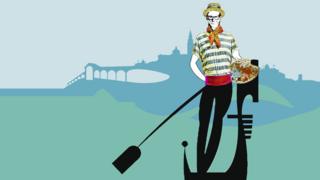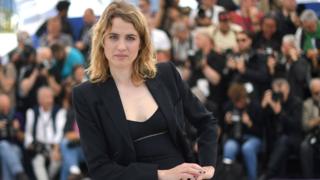
This week’s invite only “Private View” of the Venice Biennale (which opens today) was one weird affair. It was like being dropped into the middle of a Wes Anderson movie.
The place was heaving with characters. Artists, posers, dealers, curators, billionaires, bureaucrats, fakes, freeloaders, snobs, journalists, pseuds, hustlers, and narcissists all cramming themselves into tiny spaces and noisy halls to get a glimpse of some box-fresh contemporary art.
They are not a hip crowd like you might find at Coachella or XJAZZ in Berlin. They are more clamorous than glamorous. Art is a shared interest but not the thing that truly binds them. Money and status are the currencies that count. You don’t need both, but you sure as hell need one or the other.
This is a once every-other-year event that was established in 1895 to promote Italian art before morphing into an international exhibition with countries competing to be Best in Show.
Mussolini latched onto it in the 1930s as a way of promoting his fascist agenda, leaving a faintly uncomfortable air of nationalism around what is now a global contemporary art event based around nation states.
Nobody has time for anything more than a quickie.
Take a look, take a picture, post to Instagram, move on.
It is relentless.
Image copyright
Marton Monus
Visitors experiencing the Japanese Pavilion, where recorders suspended from the ceiling are played by an algorithm
The spaces serving free alcohol always seem to be most popular. Or those that have suddenly become “hot” as word of some “amazing work!!!!!” spreads like a virus through the Giardini Gardens, which serve as the Biennale’s picturesque base camp.
Anxiety levels are at fever pitch, fuelled by double espressos and a FOMO so profound that you can see the terror lurking in the eyes behind every pair of Tom Ford sunglasses.
The scale of the event is staggering.
There are 90 national pavilions, each with its own bespoke exhibition featuring the work of an artist, or artists, commissioned to represent the host country.
Image copyright
Jos de Gruyter and Harald Thys
With artists Jos de Gruyter and Harald Thys, the Belgian Pavilion say it’s offering an “anthropological experience, reminiscent of an old Europe”
Added to this is a colossal one-off exhibition spanning two massive buildings, which this year has been put together by a curator called Ralph Rugoff whose day job is running the Hayward Gallery on London’s Southbank.
There’s more.
As if the aforementioned wasn’t enough to satisfy even the most insatiable art lover, there are myriad other off-site shows by those not invited to take part in the main event: a sort of Venice Biennale Fringe, I suppose.
No sane person needs this much art, it is totally overwhelming while, paradoxically, also frequently being totally underwhelming. If the Venice Biennale was a climbing rose it would have been hacked back to manageable proportions long ago.
But it is not.
It is a hugely successful trade show-cum-visitor attraction, to which hundreds of thousands of tourists will venture over the long hot summer looking for meaning, guidance and some intellectual sustenance in our increasingly secular, divided, complicated world.
Will they find what they are looking for in the 2019 edition? You’d hope so. I did.
Not in the German Pavilion, which contains an austere post-industrial installation so earnest it is unintentionally funny.
Image copyright
Jasper Kettner
The German Pavilion says it is exploring possibilities of survival, resistance and solidarity
Quite unlike the French Pavilion opposite, which is hilarious on purpose.
The Turner Prize-winning artist Laure Prouvost has created a surreal grotto full of love, humour and ebullient eccentricity. If the Venice Biennale is a theme park of sorts, then Prouvost’s invitation to climb into the belly of an octopus is its star attraction.
You enter through a narrow back door and step into an excavated basement the artist and her bunch of merry pranksters dug in order to enter the locked Pavilion in January having tunnelled from the bed of Venice’s Grand Canal. That’s their story anyway. And by way of corroboration, they have laid out their evidence in the room above in the grubby form of dredged detritus such as old plastic bottles, rusted cans and stinking seaweed.
The floor is light blue with a translucent, gummy surface that tricks you into thinking you’re tiptoeing through dirty canal water. Go with the flow and it eventually leads you into the guts of the artist’s eight-limbed cephalopod, which is very dark place.
Image copyright
Giacomo Cosua
Laure Prouvost’s Deep See Blue Surrounding You at the French Pavilion is tipped to win the Golden Lion
An elegiac film plays amid scattered stone-effect chairs placed on a spongy carpet that genuinely feels as though it could be the lining of an octopus’s stomach.
It’s disconcerting. And nuts: an eccentric but sincere celebration of the wonderful gift that is the human imagination.
It might well win the top prize.
It’d get my vote.
But there is some strong competition. The Lithuanians have built an off-site beach complete with sunbathers whom you peer down upon as they break out into operatic song.
Image copyright
Andrej Vasilenko
The Lithuanian Pavilion has been transformed into a Sun and Sea Marina, where participants give a contemporary opera performance
And there was a lot of chatter about the Philippine Pavilion, which features an archipelago of glass topped platforms on which you walk and look down at household objects arranged beneath your feet. It was fine, but rather like the glass walkway, hardly shattering.
The Ghanaian Pavilion, on the other hand, is excellent and will give Prouvost’s watery world a run for its money when it comes to the award of the coveted Golden Lion for Best National Pavilion.
It has been designed by the architect David Adjaye who has created a series of galleries of roughly-finished curved walls, on which hangs some first-class art. A group of El Anatsui’s famous bottle-top wall hangings fill one space; behind them is a tear-inducing three-screen film by John Akomfrah that tackles climate change, imperialism, and the mistreatment of animals. And best of all, in the circular centre, are nine portrait paintings of imagined subjects by the talented Lynette Yiadom-Boakye (who was a Turner Prize runner up in 2013 the year Laure Prouvost won).
Image copyright
David Levene
One of the series of imagined portraits, Just Amongst Ourselves (2019) painted by Lynette Yiadom-Boakye, and shown at the Ghana Pavilion
Other highlights include Michael Armitage’s paintings (and sketches), which are in the main exhibition, as are those by rising star Njideka Akunyili Crosby.
Both are well worth seeking out, as is Arthur Jaffa: three to see among a plethora of half-baked mechanical contraptions and dreary installations made by various artists who could be collective known as Phil Hall.
Image copyright
ANDREA AVEZZU
Michael Armitage, who weaves multiple narratives into his works, is one of the 79 artists included in curator Ralph Rugoff’s exhibition
Image copyright
Francesco Galli Viterbo
The Nigerian-born artist Njideka Akunyili Crosby draws on political and personal references, to create densely layered figurative compositions
Another tip should you decide to take on the Venice Biennale challenge.
Carve out some time to see Edmund de Waal’s installation at the Jewish Museum (about 30 minutes from the Giardini Gardens by Vaporetto) in the Campo Ghetto Novo. The potter and author of the best-selling memoire Hare with the Amber Eyes has made a delicate and thoughtful group of new work and placed it with sensitivity around the sixteenth-century synagogue, Canton Scuola.
Image copyright
Edmund de Waal
The author and ceramicist Edmund de Waal created works of porcelain, marble and gold to reflect the literary and musical heritage of the Jewish Ghetto
By the end of your marathon art trek you’ll be ready to finish yourself off with a couple of large Bellinis. The drink that is, not the painter.












